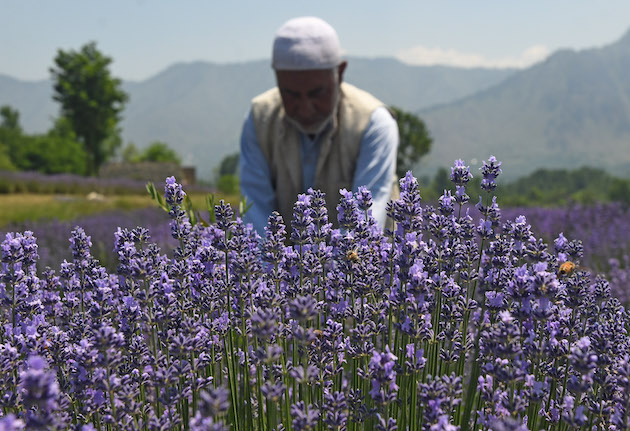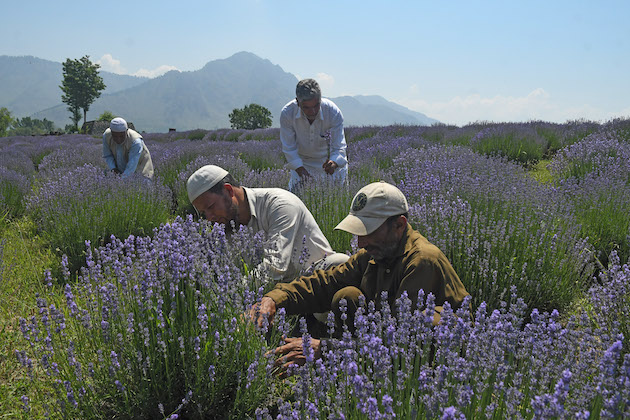Wrecked by Climate Change, Farmers in Kashmir Shift to Lavender Cultivation

BIJBEHARA, INDIA, Sep 29 (IPS) - Creating resilience is crucial to climate change justice. In Bijbehara, a hamlet south of Kashmir's capital, Srinagar, lavender farming has meant farmers grappling with unseasonal rains, prolonged heat waves, and severe water scarcity have found a new means of survival.
Mohammad Subhan Dar diligently tends to some bright purple plants on a four-acre farm in Bijbehara, a hamlet south of Kashmir’s capital, Srinagar. As you draw nearer, you’ll be mesmerized by the sight of sprawling lavender fields, where about 10 to 15 farmers, including Dar, prepare for a promising harvest.
Smiles grace the faces of these hardworking individuals as the harvest season draws near.
However, this hasn’t always been the case. The farmers in this village were deeply troubled by the significant shifts in weather patterns. Unseasonal rains, prolonged heat waves, and severe water scarcity have become constant sources of concern for them.
Kashmir Valley - a northern Indian state bordering Pakistan - has agriculture as its primary source of livelihood. Farmers comprise 80 percent of the state’s population, and agriculture and horticulture are the backbone of the state’s economy. The unique climate in the foothills of the Himalayas allows for the growing of exotic fruits and vegetables not usually found in India.
According to government records, an estimated 60 percent of Kashmir’s agriculture is dependent on rainwater for irrigation. However, during the past few years, Kashmir Valley has witnessed the worst-ever dry seasons. Meteorological Department shows that instead of an average of 622 mm of snow, the mountain ranges in Valley during the past three years witnessed a mere 172 mm - indicating a problematic change in the weather pattern. This has directly affected the region’s agriculture sector, with farmers incurring devastating losses.

Mohammad Subhan Dar is one such farmer who, in 2018, decided to abandon farming forever.
“My huge chunk of land gave me no income. It was like working round the year and getting nothing in the end. While we sowed the paddies, hoping for profitable yields, the dry weather would leave us wrecked. We would not be able even to get basic costs mitigated, let alone earn anything out of it,” Dar told IPS.
Around this time, the government’s Department of Agriculture asked farmers if they could switch to alternate farming methods that could provide them profitable harvests owing to indications of climate change in the region. Lavender farming was provided as a viable alternative.
Lavender is a valuable source for extracting essential oils, which finds its way into creating various products, including soap, cosmetics, fragrances, air fresheners, and medicinal items. Notably, lavender plants are not particularly water-thirsty and tend to resist pests and other crop-damaging creatures. A single lavender plant can start being harvested after just two years from planting, continues to bloom for up to fifteen years, and demands minimal maintenance.
Lavender farming was initiated as part of the ‘Aroma Mission,’ a collaborative effort between the Council of Scientific and Industrial Research and the Indian Institute of Integrative Medicine under the Ministry of Science and Technology.
Following the successful completion of Phase I, CSIR has embarked on Phase II, a larger endeavour that aims to involve more than 45,000 skilled individuals and benefit over 75,000 families. According to officials, the climate in Jammu and Kashmir is exceptionally well-suited for lavender cultivation, given its ability to thrive in cold temperatures and moderate summer conditions.
The Kashmir region within the Union Territory of Jammu and Kashmir is widely recognized as a significant centre for medicinal plants. Lavender holds excellent promise as a therapeutic and aromatic herb that can positively impact India’s economic and healthcare prospects. The lavender produced in Kashmir has garnered attention from both domestic and international markets. Research findings have indicated that lavender farming can be lucrative for farmers, provided there is sustained demand and well-organized farmer activities.
Dar says he had a chunk of land adjacent to his paddy field, and other villagers had pockets of cultivable lands there.
“We joined hands, got training from the government, and began the cultivation of lavender. It needs meagre care, and climate change doesn’t affect its production in any manner. It was a win-win situation for us. The hopes were high from the very beginning. As we slowly ventured into it, we found its importance,” Dar says.
Another farmer, Imtiyaz Ahmad, says the profit from Lavender farming is far greater than rice cultivation and that the farmers are a little worried about losses if the weather remains bad.
“There is nothing like dry weather or heavy rainfalls here that could affect the lavender cultivation. The research done at the government level has revealed how suitable this place is for lavender crops. Farmers in large numbers are switching to lavender cultivation and abandoning the traditional methods that used to provide them nothing except anxiety and losses,” Ahmad said.
Farmers claim that selling at least one litre of its oil fetches them Rs 30,000 (500 USD). The farmers say that lavender grown over one hectare of land gives them a minimum of 50 litres of lavender oil.
As per the government estimates, over 1,000 farming families are currently engaged in lavender cultivation across more than 200 acres in various regions of Jammu and Kashmir. Each of these farmers has provided employment opportunities to at least five additional individuals, resulting in the mission already benefiting over 6,000 families.
“Farmers in the districts of Anantnag, Pulwama, Budgam, Ganderbal, and Kupwara have begun to shift away from traditional crops and are increasingly embracing lavender cultivation,” a senior government official told IPS.
Dar believes that it has secured his future.
"It proved to be the best alternative to traditional farming in times of the drastic changes occurring at a frantic pace in Kashmir."
IPS UN Bureau Report
Follow @IPSNewsUNBureau
Follow IPS News UN Bureau on Instagram
© Inter Press Service (2023) — All Rights Reserved. Original source: Inter Press Service
Where next?
Browse related news topics:
Read the latest news stories:
- Energy Transfers Lawsuit Against Greenpeace Is an Attempt to Drain Our Resources and Silence Dissent Friday, April 04, 2025
- Global Disability Summit Galvanizes Education Support for Crisis-Impacted Children with Disabilities Thursday, April 03, 2025
- World Autism Awareness Day 2025: Sustainable Development Must Include Neurodivergent Perspectives Thursday, April 03, 2025
- Solar-Powered Spinning Machines Help Indian Women Save Time and Earn More Thursday, April 03, 2025
- DR Congo: Millions Facing Destitution as Violence Forces People to Flee Multiple Times Thursday, April 03, 2025
- ‘Every piece tells a story’: Bombs to beauty, from Gaza to Ukraine Thursday, April 03, 2025
- DR Congo: Armed violence displaces thousands as cholera outbreak worsens Thursday, April 03, 2025
- World News in Brief: Israeli military escalation in Syria, Nicaragua rights probe, South Sudan talks Thursday, April 03, 2025
- Gaza: UN rights chief calls for probe into killings of medical workers Thursday, April 03, 2025
- UN envoy urges international support for West Africa and the Sahel Thursday, April 03, 2025
Learn more about the related issues:

